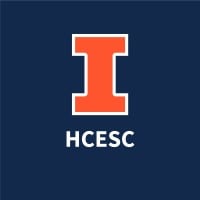Company Details
health-care-engineering-systems-center
10,001
462
None
illinois.edu
0
HEA_2120847
In-progress

Health Care Engineering Systems Center at Illinois Company CyberSecurity Posture
illinois.eduThe Health Care Engineering Systems Center (HCESC) at the University of Illinois at Urbana-Champaign provides clinical immersion and fosters collaboration between engineers and physicians. The goal is to use our expertise in the broad areas of simulation technologies, smart health systems, data analytics, human factors, and medical robotics to design and develop collaborative solutions that improve health care outcomes. HCESC was established in 2014 as a research center housed under the Coordinated Science Laboratory in The Grainger College of Engineering. We have grown as a place where engineering meets medicine in innovative ways, playing leadership roles in simulation, health data analytics, medical robotics, and education. One of the most important activities of our center is managing the Jump Applied Research in Community Health through Engineering and Simulation (ARCHES) endowment, which was established in 2014 by a $62.5 million gift. Jump ARCHES is a partnership between Jump Simulation and Education Center at OSF HealthCare in Peoria and HCESC. The endowment provides direct access and competitive grants for engineers and clinicians of every discipline to work together and solve problems in the world of healthcare. These competitive grants are available to employees of the University of Illinois at Urbana-Champaign, University of Illinois College of Medicine Peoria, and OSF HealthCare Systems. Proposal requests are accepted twice annually. Since its inception, Jump ARCHES has provided over $2 million through an internal grant mechanism to fund over 40 proposals. In 2019, the Jump ARCHES partnership was expanded with new commitments of $50 million, backed by a total of $112.5 million in endowment support. This multifaceted expansion included a $25 million gift from the DiSomma Family Foundation to the endowment pool held within the OSF HealthCare Foundation, an additional $12.5 million commitment from the OSF HealthCare Foundation, and an equivalent $12.5 mi
Company Details
health-care-engineering-systems-center
10,001
462
None
illinois.edu
0
HEA_2120847
In-progress
Between 750 and 799

 HCESCI Global Score (TPRM)
HCESCI Global Score (TPRM)XXXX



No incidents recorded for Health Care Engineering Systems Center at Illinois in 2025.
No incidents recorded for Health Care Engineering Systems Center at Illinois in 2025.
No incidents recorded for Health Care Engineering Systems Center at Illinois in 2025.
HCESCI cyber incidents detection timeline including parent company and subsidiaries

The Health Care Engineering Systems Center (HCESC) at the University of Illinois at Urbana-Champaign provides clinical immersion and fosters collaboration between engineers and physicians. The goal is to use our expertise in the broad areas of simulation technologies, smart health systems, data analytics, human factors, and medical robotics to design and develop collaborative solutions that improve health care outcomes. HCESC was established in 2014 as a research center housed under the Coordinated Science Laboratory in The Grainger College of Engineering. We have grown as a place where engineering meets medicine in innovative ways, playing leadership roles in simulation, health data analytics, medical robotics, and education. One of the most important activities of our center is managing the Jump Applied Research in Community Health through Engineering and Simulation (ARCHES) endowment, which was established in 2014 by a $62.5 million gift. Jump ARCHES is a partnership between Jump Simulation and Education Center at OSF HealthCare in Peoria and HCESC. The endowment provides direct access and competitive grants for engineers and clinicians of every discipline to work together and solve problems in the world of healthcare. These competitive grants are available to employees of the University of Illinois at Urbana-Champaign, University of Illinois College of Medicine Peoria, and OSF HealthCare Systems. Proposal requests are accepted twice annually. Since its inception, Jump ARCHES has provided over $2 million through an internal grant mechanism to fund over 40 proposals. In 2019, the Jump ARCHES partnership was expanded with new commitments of $50 million, backed by a total of $112.5 million in endowment support. This multifaceted expansion included a $25 million gift from the DiSomma Family Foundation to the endowment pool held within the OSF HealthCare Foundation, an additional $12.5 million commitment from the OSF HealthCare Foundation, and an equivalent $12.5 mi


Chez Ipsos, nous sommes passionnément curieux des individus, des marchés, des marques et de la société. Nous aidons nos clients à naviguer plus vite et plus aisément dans un monde en profonde mutation. Nous leur apportons l'inspiration nécessaire à la prise de décisions stratégiques. Nous

The Spanish National Research Council (Consejo Superior de Investigaciones Científicas-CSIC) is a government agency for basic and applied scientific research. It is the largest public research performing organisation in Spain, with 126 centers. El Consejo Superior de Investigaciones Científicas (

Aarhus Universitet blev grundlagt i 1928 og er i dag i den absolutte verdenselite på flere forskningsfelter. Aarhus Universitet (AU) er blandt verdens 10 bedste universiteter grundlagt inden for de seneste 100 år og har en lang tradition for partnerskaber med nogle af verdens bedste forskningsinst

Københavns Universitet er med cirka 40.000 studerende og 9.000 medarbejdere en af Nordens største forsknings- og uddannelsesinstitutioner. Københavns Universitets mål er at drive forskning af højeste kvalitet, at tilbyde forskningsbaseret uddannelse til det højeste akademiske niveau, og at formid
.png)
Our commitment to audit quality. At EY US, we are bringing our bold vision for the future of audit to life with quality at the center, and...
In 2023, 725 data breaches were reported to OCR and across those breaches, more than 133 million records were exposed or impermissibly disclosed.
These companies block online threats, assess industry vulnerabilities and increase education and awareness about cybersecurity.
9/5/2025 4 min read. Share on Facebook · Share on Twitter · Share on LinkedIn. Written by. The Grainger College of Engineering is proud to...
Develop your skills alongside leaders with a global organization that values your growth and encourages you to improve the health care landscape.
The healthcare sector faces a rapidly increasing range of cybersecurity threats, with ransomware attacks emerging as one of the most significant.
As the United States invests in transforming its manufacturing sector to reduce emissions and produce clean technologies, it has an...
Capital One and the University of Illinois Urbana-Champaign are pleased to announce the launch of the Center for Generative AI Safety,...
Role models for students, parents, educators, and the cybersecurity community Sponsored by Secureworks.

Explore insights on cybersecurity incidents, risk posture, and Rankiteo's assessments.
The official website of Health Care Engineering Systems Center at Illinois is http://healtheng.illinois.edu.
According to Rankiteo, Health Care Engineering Systems Center at Illinois’s AI-generated cybersecurity score is 755, reflecting their Fair security posture.
According to Rankiteo, Health Care Engineering Systems Center at Illinois currently holds 0 security badges, indicating that no recognized compliance certifications are currently verified for the organization.
According to Rankiteo, Health Care Engineering Systems Center at Illinois is not certified under SOC 2 Type 1.
According to Rankiteo, Health Care Engineering Systems Center at Illinois does not hold a SOC 2 Type 2 certification.
According to Rankiteo, Health Care Engineering Systems Center at Illinois is not listed as GDPR compliant.
According to Rankiteo, Health Care Engineering Systems Center at Illinois does not currently maintain PCI DSS compliance.
According to Rankiteo, Health Care Engineering Systems Center at Illinois is not compliant with HIPAA regulations.
According to Rankiteo,Health Care Engineering Systems Center at Illinois is not certified under ISO 27001, indicating the absence of a formally recognized information security management framework.
Health Care Engineering Systems Center at Illinois operates primarily in the Research industry.
Health Care Engineering Systems Center at Illinois employs approximately 10,001 people worldwide.
Health Care Engineering Systems Center at Illinois presently has no subsidiaries across any sectors.
Health Care Engineering Systems Center at Illinois’s official LinkedIn profile has approximately 462 followers.
No, Health Care Engineering Systems Center at Illinois does not have a profile on Crunchbase.
Yes, Health Care Engineering Systems Center at Illinois maintains an official LinkedIn profile, which is actively utilized for branding and talent engagement, which can be accessed here: https://www.linkedin.com/company/health-care-engineering-systems-center.
As of November 27, 2025, Rankiteo reports that Health Care Engineering Systems Center at Illinois has not experienced any cybersecurity incidents.
Health Care Engineering Systems Center at Illinois has an estimated 1,199 peer or competitor companies worldwide.
Total Incidents: According to Rankiteo, Health Care Engineering Systems Center at Illinois has faced 0 incidents in the past.
Incident Types: The types of cybersecurity incidents that have occurred include .
.png)
Angular is a development platform for building mobile and desktop web applications using TypeScript/JavaScript and other languages. Prior to versions 19.2.16, 20.3.14, and 21.0.1, there is a XSRF token leakage via protocol-relative URLs in angular HTTP clients. The vulnerability is a Credential Leak by App Logic that leads to the unauthorized disclosure of the Cross-Site Request Forgery (XSRF) token to an attacker-controlled domain. Angular's HttpClient has a built-in XSRF protection mechanism that works by checking if a request URL starts with a protocol (http:// or https://) to determine if it is cross-origin. If the URL starts with protocol-relative URL (//), it is incorrectly treated as a same-origin request, and the XSRF token is automatically added to the X-XSRF-TOKEN header. This issue has been patched in versions 19.2.16, 20.3.14, and 21.0.1. A workaround for this issue involves avoiding using protocol-relative URLs (URLs starting with //) in HttpClient requests. All backend communication URLs should be hardcoded as relative paths (starting with a single /) or fully qualified, trusted absolute URLs.
Forge (also called `node-forge`) is a native implementation of Transport Layer Security in JavaScript. An Uncontrolled Recursion vulnerability in node-forge versions 1.3.1 and below enables remote, unauthenticated attackers to craft deep ASN.1 structures that trigger unbounded recursive parsing. This leads to a Denial-of-Service (DoS) via stack exhaustion when parsing untrusted DER inputs. This issue has been patched in version 1.3.2.
Forge (also called `node-forge`) is a native implementation of Transport Layer Security in JavaScript. An Integer Overflow vulnerability in node-forge versions 1.3.1 and below enables remote, unauthenticated attackers to craft ASN.1 structures containing OIDs with oversized arcs. These arcs may be decoded as smaller, trusted OIDs due to 32-bit bitwise truncation, enabling the bypass of downstream OID-based security decisions. This issue has been patched in version 1.3.2.
Suricata is a network IDS, IPS and NSM engine developed by the OISF (Open Information Security Foundation) and the Suricata community. Prior to versions 7.0.13 and 8.0.2, working with large buffers in Lua scripts can lead to a stack overflow. Users of Lua rules and output scripts may be affected when working with large buffers. This includes a rule passing a large buffer to a Lua script. This issue has been patched in versions 7.0.13 and 8.0.2. A workaround for this issue involves disabling Lua rules and output scripts, or making sure limits, such as stream.depth.reassembly and HTTP response body limits (response-body-limit), are set to less than half the stack size.
Suricata is a network IDS, IPS and NSM engine developed by the OISF (Open Information Security Foundation) and the Suricata community. In versions from 8.0.0 to before 8.0.2, a NULL dereference can occur when the entropy keyword is used in conjunction with base64_data. This issue has been patched in version 8.0.2. A workaround involves disabling rules that use entropy in conjunction with base64_data.

Get company history
















Every week, Rankiteo analyzes billions of signals to give organizations a sharper, faster view of emerging risks. With deeper, more actionable intelligence at their fingertips, security teams can outpace threat actors, respond instantly to Zero-Day attacks, and dramatically shrink their risk exposure window.
Identify exposed access points, detect misconfigured SSL certificates, and uncover vulnerabilities across the network infrastructure.
Gain visibility into the software components used within an organization to detect vulnerabilities, manage risk, and ensure supply chain security.
Monitor and manage all IT assets and their configurations to ensure accurate, real-time visibility across the company's technology environment.
Leverage real-time insights on active threats, malware campaigns, and emerging vulnerabilities to proactively defend against evolving cyberattacks.




